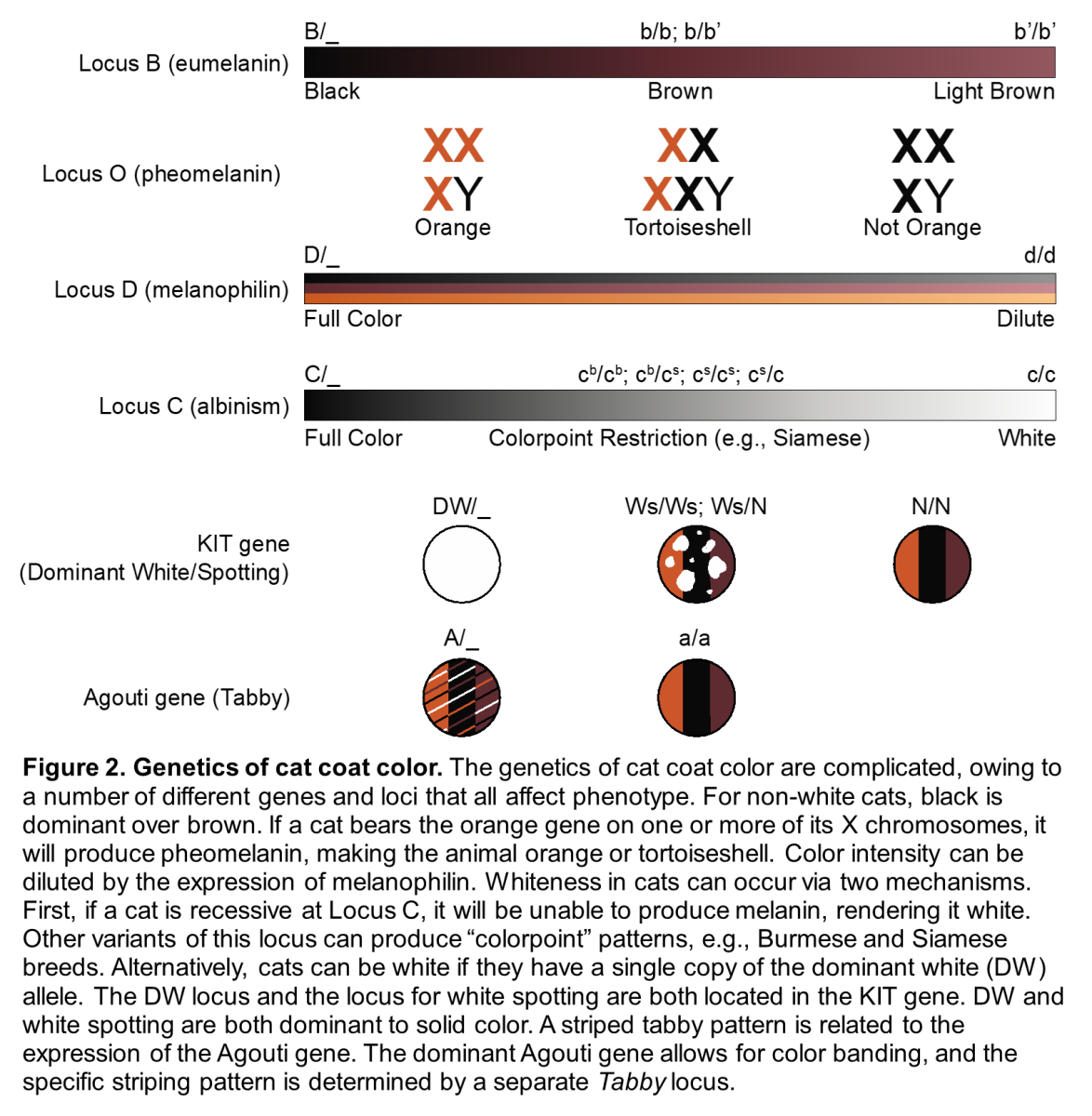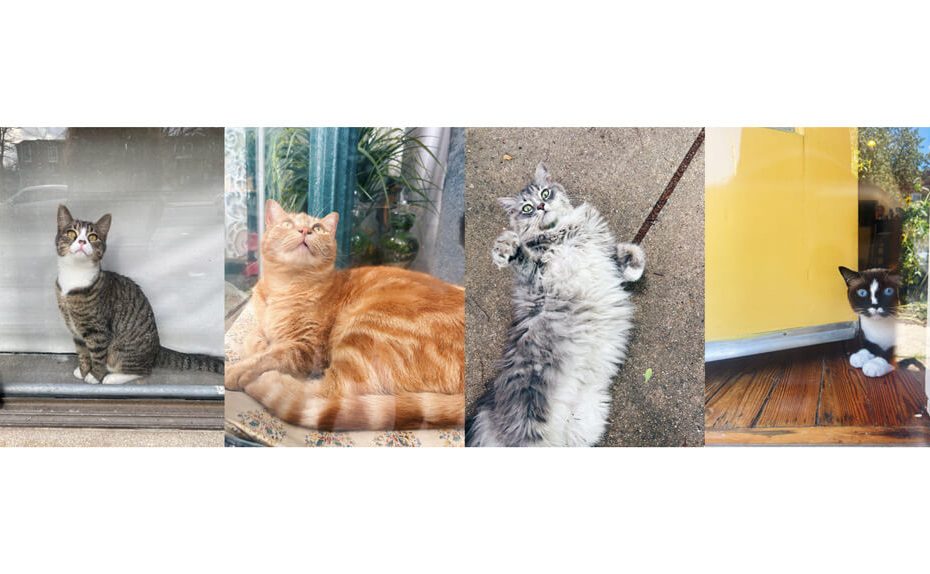Photos courtesy of the author.
Introduction
Cats are both celebrated and maligned for their aloof nature, ardent curiosity and playful attitude. Despite their mercurial behavior, cats are the second most popular choice for pets in America — 46.5 million U.S. households have at least one cat, with close to half of those having two or more cats. However, stray and feral cats are also a significant portion of the American feline population. It is not possible to know the exact number of outdoor cats, but estimates range from 30 million to 80 million animals, indicating that there are between one and three stray cats for every two pet cats. Still, stray cats have been bred to live alongside humans, and approximately 10% of unhoused cats are “community cats,” fed and supported by public admirers.
In this report, I present my personal observations of cats in Baltimore, including cat appearance and disposition. Herein, I describe a highly diverse population of cats, representative of the incredible complexity of cat phenotype genetics. Moreover, the vast majority of cats demonstrated a positive affect. In summary, I find the cats of Baltimore to be uniformly cute, and generally friendly.
Methods
All cats in this report were observed between January and October 2023. Recordings were taken on the Johns Hopkins University medical campus and in the following Baltimore neighborhoods: Canton, Downtown Baltimore, Fells Point, Mt. Vernon and Upper Fells Point. Cats were photographed when possible, allowing for subsequent visual identification and precise geographical documentation. Animals were observed in their native environment and no experimental manipulation was performed on subjects; as such, IRB approval was not warranted.
Note: Cats on leashes (two instances; one Bengal, one black and white) were not included in data analysis as they are not representative of the general cat population. Moreover, for any given cat, on-leash behavior is not necessarily indicative of overall temperament.
Technical Limitations
The following caveats must be considered when evaluating the data included in this study. First, the cats observed represent a small proportion of the cats of Baltimore, and thus, extrapolating these data to any larger population of cats should not be performed. Moreover, it is practically challenging to observe stray cats. Thus, this cohort is under sampled.
Behavioral conclusions should be especially regarded as biased due to the method of data collection. All observations were unplanned; no cats were sought out for the specific purpose of classification. Therefore, the cats described in this study will be, on average, more sociable.
Results
Baltimore Cats are Phenotypically Diverse
Over the course of this study, a total of 22 cats were observed and documented. The most commonly identified cat type was Orange (including Orange-and-White) (Figure 1).
Eight Orange cats were observed, representing approximately one-third of the subjects. Black-and-White and Gray-and-White cats each comprise approximately 18% of the observed population. The least frequently observed types were Brown-and-White and White, with only one animal observed per category. It should be noted that one Black-and-White cat appeared to be a chestnut brown color in sunlight.
In preparing this analysis, I found it challenging to stratify cats by their coat, as there is a high degree of overlap between coat types. Thus, a more sophisticated investigation into cat coat color was undertaken.
Cat coat appearance is determined genetically, with many different molecular contributions (Figure 2).  Coat color is determined by the expression of eumelanin (black or brown), pheomelanin (orange) and melanophilin (color dilution). The “default” color for cats is black, whereas orange color is an X-linked trait, meaning that females must be homozygous to be fully orange. If females are heterozygous, they are tortoiseshells; the tortoiseshell pattern arises due to random X chromosome inactivation, and requires multiple X chromosomes.
Coat color is determined by the expression of eumelanin (black or brown), pheomelanin (orange) and melanophilin (color dilution). The “default” color for cats is black, whereas orange color is an X-linked trait, meaning that females must be homozygous to be fully orange. If females are heterozygous, they are tortoiseshells; the tortoiseshell pattern arises due to random X chromosome inactivation, and requires multiple X chromosomes.
There are two mechanisms by which cats can have white fur. First, the cat can be recessive at Locus C, meaning that their ability to produce functional tyrosinase is affected, disrupting melanin production. Alternatively, cats can have the dominant white (DW) locus; in addition to producing white fur, DW can impair cats’ hearing. DW is on the same gene as the white spotting (Ws) allele. In the absence of DW, Ws will produce white spots. Additionally, cats will have a tabby pattern if they express the dominant form of the Agouti gene, and the specific tabby pattern is determined by a separate allele.
Given the complex nature of cat color determination, the genetic identity of each of the cats observed cannot be stated with any degree of certainty. Still, the appearance of all four major coat colors (black, brown, orange and white), as well as patterns and variants (dilute, spotted and striped), suggests that Baltimore cats are genetically heterogeneous. Given the close proximity of multipleshelters and rescueorganizations, these results are not unexpected, as humane societies are typically populated by mixed breeds. Indeed, these findings are consistent with the hypothesis that a majority of cats in Baltimore are adopted, not purchased (i.e., from a breeder).
Window Cats Are More Frequently Observed Than Outdoor Cats
The majority of cats observed were seen in windows (approximately 80%), and therefore their friendliness could only be approximated based on their willingness to approach the researcher (Figure 3).  Based on appearance and attitude, it can be fairly assumed that all observed window cats were sociable, healthy and well loved. In the absence of being able to interact with this population, these findings bring the researcher comfort.
Based on appearance and attitude, it can be fairly assumed that all observed window cats were sociable, healthy and well loved. In the absence of being able to interact with this population, these findings bring the researcher comfort.
Of the cats observed outdoors, three of the four animals were extremely genial. Each allowed the researcher to pet the animal’s head, back and belly. Two of the cats observed outdoors were wearing collars. The donning of a collar suggests that these cats were not strays, but were “indoor/outdoor” cats, given the freedom to explore Baltimore for themselves. (One cat, Sweet Beef, was confirmed to be a companion animal upon the researcher meeting the “Owner.”)
Interestingly, both outdoor cats observed without collars were seen on the JHU medical campus. One was seen on North Broadway, near the JHMI shuttle stop. This cat was not willing to interact with humans during the time of observation. The other stray cat was observed in the tunnel next to the Rutland Garage. This cat was so friendly that it was not possible to photograph the animal, as every attempt was met with insistent headbutts, which the researcher indulged. Based on this behavior, I propose that this cat may be (or will become) a community cat, if it is not adopted.
There was no significant difference in the phenotype of outdoor cats and indoor cats (data not shown).
Discussion
In this descriptive analysis, I characterize the cats I have observed during my first 10 months living in Baltimore. I find the cats of Baltimore to be phenotypically diverse, representing many coat color variants. Additionally, the majority of cats observed were seen in windows, which was anticipated given the nature of data collection.
Prior to moving to Baltimore, I attended graduate school in Philadelphia, Pennsylvania. During my six years of residence, I observed approximately 53 cats, excluding one leashed cat (Bengal), and many cats that were displayed in an adoptive setting (e.g., while volunteering at PAWS). Of the Philadelphia cats, eight were seen outdoors, with four of these eight being indoor/outdoor cats. Compared to the data collected thus far in Baltimore, there are comparable proportions of window cats (82% Baltimore, 85% Philly), indoor/outdoor cats (9% Baltimore, 7.5% Philly) and stray cats (9% Baltimore, 7.5% Philly). However, the observed cats in Philadelphia were majority tabby, representing approximately 36% of the cohort. Whether this is indicative of underlying variation in the population genetics of each city is an open question and requires further investigation.
The ratio of cats observed to city human population is very similar for Baltimore and Philadelphia (0.000039 vs. 0.000034). However, I have become a more proficient cat spotter during the course of these studies, and I remain hopeful that I will see many additional cats as I continue to explore Baltimore. As an orthogonal strategy, an adoption-based approach is of great interest and will be purr-sued in the future.
Related Content
- Graduate School Is the Cat’s Meow
- Fur-Get Me Not: Can Dogs Recognize Other Dogs?
- Making Baltimore Home
Want to read more from the Johns Hopkins School of Medicine? Subscribe to the Biomedical Odyssey blog and receive new posts directly in your inbox.


Too many possible cat puns, too little time. Great fun mixed with good science in an accessible piece of writing. Meow!
FYI - the link in the caption for Figure 1 directs to this website: https://www.alleycat.org/resources/cat-identification-guide/
Comments are closed.